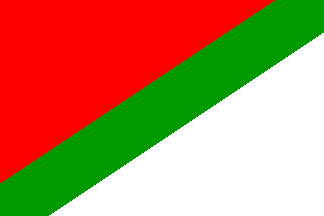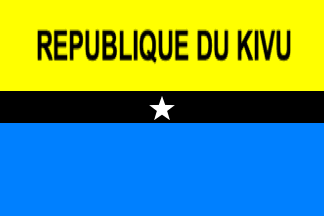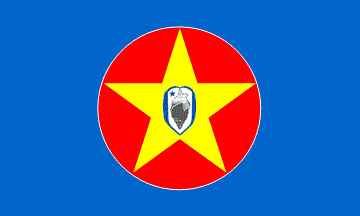![[Congo, Rep. Dem., 1960]](../images/c/cd-1960.gif) image
by Vincent Morley, 08 Jan 1997
image
by Vincent Morley, 08 Jan 1997

Last modified: 2022-10-22 by bruce berry
Keywords: kivu | kwilu | congo | gbenye | bukavu | doubt | katanga |
Links: FOTW homepage |
search |
disclaimer and copyright |
write us |
mirrors
![[Congo, Rep. Dem., 1960]](../images/c/cd-1960.gif) image
by Vincent Morley, 08 Jan 1997
image
by Vincent Morley, 08 Jan 1997
From the Flag Bulletin, vol. 3, No. 4 (Summer 1964), p. 63:
"Finally, an old flag has again been raised in the centre of Africa. A revolt against the central Congolese government at Leopoldville [now Kinshasa] has broken out in Kwilu and Kivu provinces. The Kivu rebels have established a Revolutionary Government of the Eastern Congo with headquarters at Bujumbura, the capital of Burundi. The Ruzizi Valley in Kivu is controlled by the rebels who claimed to be led by Patrice Lumumba, who in fact was killed in 1961. Their flag is the blue and gold flag with six stars which was used by the Congo from 1960 to 1963".Jos Poels, 12 Sep 1996
 image
by Toino Guifeiro, 21 Feb 1999
image
by Toino Guifeiro, 21 Feb 1999
I added in my pages a alternative image for the flag of the Republic
of Bukavu. I include in first time the flag according Oleg Tarnowski. Now,
I include the flag according Lucien Philippe. I believe that the version
of Philippe is more sure. Philippe say that the flags "is the Katanga flag
without the three cross because the crosses are a a secessionist symbol
of Katanga,
and the Bukavu flag is not that of Katanga.
Jaume Ollé, 18 Apr 1997
As Bukavu has always been the capital of Kivu it always has used its
armorial bearings — which look very different from what you have shown.
It has 3 symbolic volcanoes and the lake. It never has been used as a
flag.
Caroline Vervalcke, 16 May 1999
There were attempts at a secession of Kivu and neighbouring areas in
the past two years, but the flag shown here is much older.
I do not know much, but apparently Bukavu was one of the two centres of
Gbenye's “People's Republic of Congo”, generally described as following
the footsteps of Patrice Lumumba. The other centre was Kisangani (formerly
Stanleyville) and all this took place in 1964-65. So this Katanga-like flag
is somewhat strange, because (according to W. Smith 75
[smi75b]) Gbenye's republic
must have used the seven-star flag
[as shown above].
Thânh-Tam Lê, 31 Mar 1999
 image by Ivan Sache, 06 July 2020
image by Ivan Sache, 06 July 2020
On 01 July 2020 (Independence Day), flags of an alleged "Republique du Kivu"
appeared at different sites in the town of Bukavu. On 02 July, during the
Council of Ministers, President Félix Tshisekedi ordered the security forces to
arrest the perpetrators, who should be sued. Several people blamed the
hoisting of these flags as a provocation aimed at stirring violence in Kivu.
The flag is horizontally divided yellow-blue by a thin black horizontal stripe
charged with a white star in the centre. "REPUBLIQUE DU KIVU" is written in
black letters in the yellow stripe.
Images of the flag can be seen on various news
websites,
here and
here.
Ivan Sache, 06 July 2020
Republic of Kongo-Central
 Image by
Olivier Touzeau, 03 April 2012
Image by
Olivier Touzeau, 03 April 2012
According to
http://www.africafederation.net/Kongo_Central.htm the federal republic of
Kongo-Central (extending around Cabinda in Bas-Congo
province of Democratic Republic of Congo (DRC) and parts
of the Republic of Congo) should have a blue flag with
five (3+2) machetes. On the webpage where the drawing of the flag can be seen, a
declaration dated 2008 is shown.
This proposal is not the first, since the Republic of Kongo-Central was first
mooted in 1959 and had a revival in 1994 with another flag. A document on
africafederation.net shows not only as a drawing, but in real use, a
blue flag with a red disc and a yellow star with in the center the emblem of the
Alliance of the Bakongo (ABAKO),
which has as its main element a shell.
The flag was in use at least between 1994 and 2000, but may have been the
flag of the 1959 Republic of Kongo-Central since the document where this flag is
shown clearly states that there is a continuity between the declaration of
independence of 1959 and its revival in 1994/2004. Pictures dated
1994-1995-1996 show this flag in use.
 Image by
Olivier Touzeau, 03 April 2012
Image by
Olivier Touzeau, 03 April 2012
Some of the details about the history of the Republic of Kongo-Central taken
from this document, and especially from a memorandum by P.A. Tamankueno
Muana-Muele (Prime Minister of the clandestine government of Kongo-Central and
President of the ABAKO in Exile requesting the German federal government to
introduce to the United Nations a resolution recognizing the independent state
of Kongo-Central) prepared on 13 January 2004. Although the text of
the Memorandum is obviously very subjective, some parts of this text give
interesting clues about the origins of the Republic of Kongo-Central.
"The political party ABAKO “Alliance of the Bakongo”, was created in 1950 in
Leopoldville, while under the Belgian Colonial rule, successively headed by
Edmong Nzeze Nlandu, his founder, and by Joseph Kasa-Vubu, his first General
President, both deceased, comes forward today for the first time to request from
the German Federal Authorities to abandon the trap of Berlin 1885 and the one on
the Consensus on the creation of the R.D.C. on 30 June 1960. It can do it by
introducing a resolution in the UN, recognizing the existence of the Republic of
Kongo-Central (independent State of Kongo), rehabilitated and proclaimed on 04
January and 13 January 1959 by the Revolution of the People of Kongo, headed by
this party in Leopoldville, capital of the Belgian Congo."
....
"It is important to note that the Independent State of Kongo is the central part
of the Kingdom of Kongo, divided in Berlin. This independent State of Kongo is
therefore politically synonymous to the Republic of Kongo-Central proclaimed by
the ABAKO in 1959."
"Coming back to the Colonization, the ABAKO Party is making
clear that the Belgian Congo, the result of the annexing of the Northern and
Eastern Kingdoms of the Independent State of Kongo, was part of this
colonization policy in Central Africa. The Kongo people always fought against
colonization."
"Therefore, as soon as the ABAKO Party was founded in 1950, it and the Kongo
People engaged in a clandestine political struggle against the occupation of
Kongo-Central by Belgium. The Leaders of the ABAKO Party studied all the
conventions stemming from the Berlin Conference in 1885 and noticed that the
right to self-determination and independence of each nation included in the
Independent State of Kongo by the Belgian colonial power was envisioned."
...
"The date of 13 January 1959 in the history of the Belgian colonization in
Central Africa must be brought to your attention. It was on that day that
Belgium asked the rest of the Belgian Congo, by the way of a governmental
declaration, which refused any act of independence, by the way of a vote on
December 20th,1959. It included the Kasai, the Katanga, the Kivu, the Uele
or Stanleyville and the Equator (Mbandaka) or Coquilhatville, which always
waited for the promise from Belgium to grant independence."
"Rejecting totally the Belgian governmental declaration and the elections,
previously mentioned, the ALBAKO Party decided for the immediate and
unconditional independence on 13 January 1959 and set up the Government of the
People of Kongo, preceded by the proclamation of the Republic of Kongo-Central
with the President of the ABAKO as President before 1960. In front of this
unexpected situation, the colonial power organized a round table discussion in
Brussels in 1960. It resulted in a series of agreements and commitments between
the Belgium government, the ABAKO Party and the remaining pans of the Belgian
Congo. It led to the foundation of the DRC on 30 June 1960, which remained in
existence until 30 June 1970, without any disturbance. ... It is in those
conditions that Belgium proclaimed the immediate and unconditional independence
on 30 June 1960. "
...
"Already on 30 June 1960, until the time of the solemn declaration of
independence, the Prime Minister, P.E. Lumumba, produced a speech full of
insults, not planned by the protocol. Hence the beginning of troubles and
rebellions which will follow, without mentioning attempted coups d'etat,
massacres and assassinations, which are still part of the world scene today."
...
"Instead of waiting the 10 year period, granted to the DRC i.e. until June 30th,
1970, the Katanga led by Mr Moise Tschombe , helped by 10,000 Belgian
paratroopers and the Kasai, led by Mr. A. Kalondji, proclaimed the independence
of the State of Katanga and Kasai. Had they respected the deadline, their acts
wouldn’t have had been treated as rebellions and secessions after 30 June 1970."
"Anyway, and within the framework of the agreements and commitments on the
creation of the DRC and on the agreed meeting, the ABAKO Party was kept informed
day by day of the visit to Leopoldville of His Majesty‘ King Bandouin I between
17 June and 30 June 1970, followed by a large Belgian delegation."
"But the dictator Mobutu, who seized power through a coup on 24 November 1965
asked for a delay and in the meantime, physically eliminated all the leaders of
the ABAKO Party. He was able to confiscate the copy of the Declaration of
the postponement, which was kept by His Eminence Joseph DIANGENDA - spiritual
leader of the Kimbanguiste Church - until his murder by poisoning by Mobutu
himself.
"If the delegation of the ABAKO Parry and the People of Kongo at the round table
conference in Brussels had known that they would have had to deal with sides
that wouldn’t respect those agreements and commitments, the conference in
Brussels wouldn’t have had taken place and the DRC would not have not been
founded without the people of Kongo."
"At the same time, in one of its previous paper, the ABAKO Party stated that the
former Belgian Congo has become a case for the International Law Courts. On this
subject, this party, owner of the immediate and unconditional independence of 04
January 1959, has already informed the international community, that what ever
happens in the former Belgian Congo, without this party has no political and
historical legitimism. It is a complicity of those parties which brought in an
unexpected agreement that led to the creation of the DRC."
"Through this paper, the ABAKO Party has exposed the two clandestine conferences
that took place in 1959 and 1994 in the occupied Kongo-Central, under the
dictatorship of Mobutu which led to the Rehabilitation or
Declaration of the Republic of Kongo-Central, putting in place a clandestine
fighting government, in full activity up until this day."
Olivier Touzeau, 03 April 2012